CeraVe’s Daily Moisturizing Lotion and La Roche Posay’s Cicaplast Baume B5 are moisturizers that blew up on platforms such as TikTok due to being recommended by many skincare influencers and professionals in the industry.
Both moisturizers are packed with excellent ingredients; however, they won’t necessarily work for all skins and skin conditions.
And since acne is definitely a skin condition that requires a lot of care and attention on what’s being applied to the skin, there might be some potential side effects such as flare-ups if the wrong product is used.
Therefore, having used them both on my oily and acne-prone skin, in this review, I will discuss the La Roche Posay Cicaplast Baume B5 vs CeraVe Daily Moisturizing Lotion and decide which one is better for acne.
And without any further ado, let’s jump right into it:
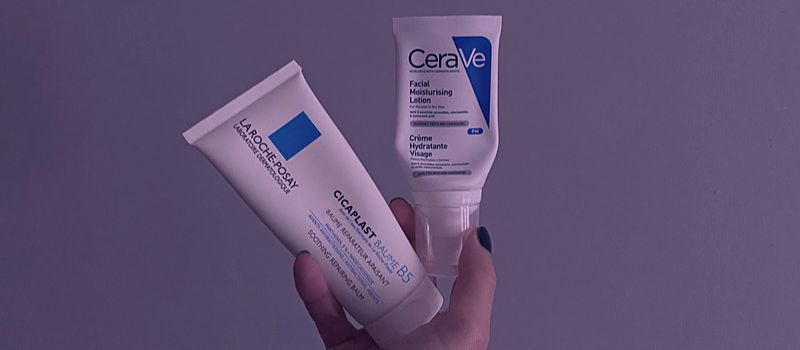
CeraVe Daily Moisturizing Lotion
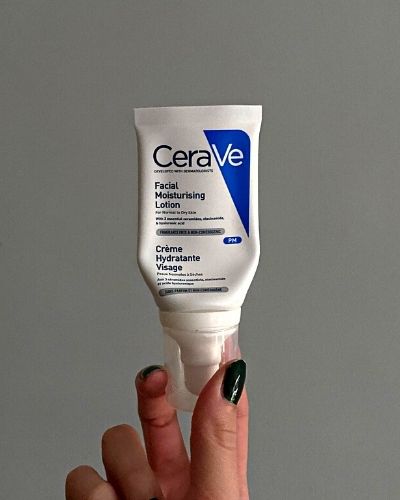
CeraVe Daily Moisturizing Lotion is a lightweight moisturizer formulated with ingredients that work together to strengthen the skin barrier by locking moisture into the upper layers of the epidermis.
After application, the skin is left feeling soft, comfortable, and hydrated for up to 24 hours.
Ingredients
The CeraVe Daily Moisturizing Lotion is formulated with ingredients like ceramides, hyaluronic acid, and niacinamide, as well as fatty components such as Cetyl and Cetearyl alcohol that soften the skin and strengthen its barrier.
However, along with the ingredients that are safe for acne, the lotion also contains Polyglyceryl-3 Diisostearate, a natural emulsifier that brings a soft and powdery feel to the formula.
The ingredient itself is gentle, and you can often find it in products formulated for sensitive and baby skin.
But this ingredient can also become a potential problem for those with acne or acne-prone skin.
Besides being gentle and relatively non-problematic for some, Polyglyceryl-3 Diisostearate is a heavier emollient and can be pore-clogging.
Scent
CeraVe’s Daily Moisturizing Lotion doesn’t have added fragrance or fragrant components, and it doesn’t have a scent.
Consistency
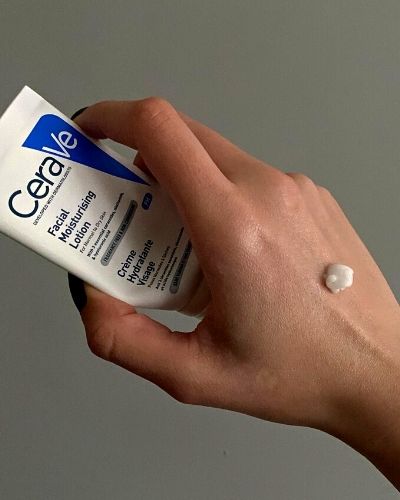
CeraVe’s Daily Moisturizing Lotion has a consistency that could be described as something between a gel and a moisturizer.
It’s fairly lightweight, and it glides on the skin with ease. It’s definitely not heavy; however, once applied to the skin, the moisturizer does leave a glowy layer.
This might not be the case with someone who has dry skin, but as someone with very oily skin, the shine was prominent on my skin.
How to Use the CeraVe Daily Moisturizing Lotion for Acne?
The correct way to use the CeraVe Daily Moisturizing Lotion is after cleansing your skin or after applying your acne treatments.
Take a pea-sized amount of the lotion and gently massage it into damp skin, allowing it to absorb fully.
The moisturizer can be used twice daily, in the morning before sunscreen and at night, as the final step in your routine.
Performance
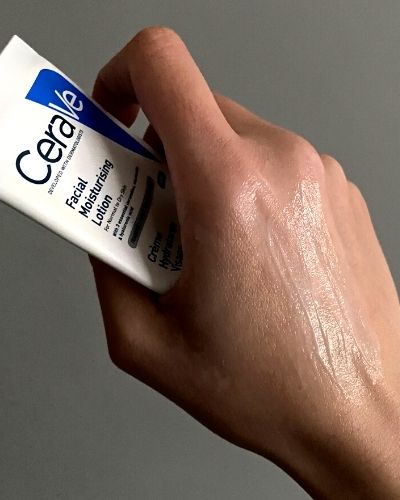
CeraVe’s Daily Moisturizing Lotion worked well on me until it didn’t.
Let me explain.
I started using this moisturizer alongside Paula’s Choice CLEAR Anti-Redness Solution with 2% Salicylic Acid, and I enjoyed the lightweight consistency.
However, soon after I started using it, pimples began popping up in areas where I usually break out when my pores are clogged, such as my cheeks, instead of areas where I typically purge, such as my temples and forehead, so I knew this wasn’t a purge but a breakout.
I wasn’t going to give it a chance to continue to break me out; therefore, I stopped it immediately, and the pimples were gone after a few days of my regular skincare routine.
This is also something I’ve read from other users on platforms such as Reddit and Twitter, and since I already knew the moisturizer contains a few potentially clogging ingredients, I never gave it another chance.
On the brighter side, my partner, who has normal to dry skin, ended up loving it and has been using it religiously for around three years at the time of this writing.
So, it’s safe to say that the Daily Moisturizing Lotion isn’t a bad product; however, I would definitely recommend that anyone who has excessively oily and acne-prone skin be careful with it.
Additionally, I have also seen the CerVe Daily Moisturizing Lotion being touted as the holy grail for use alongside tretinoin due to its hydrating and skin-softening properties that can help relieve dryness and irritation caused by tretinoin; however, I would still caution those who are using tretinoin for acne to be careful with this product.
Using products with comedogenic ingredients that continue to clog your pores will constantly “give” tretinoin something to purge; therefore, you may never experience the positive effects of using tretinoin but may end up in a constant purging loop, which can damage your skin barrier and even trigger permanent conditions, such as rosacea.
La Roche Posay Cicaplast Baume B5
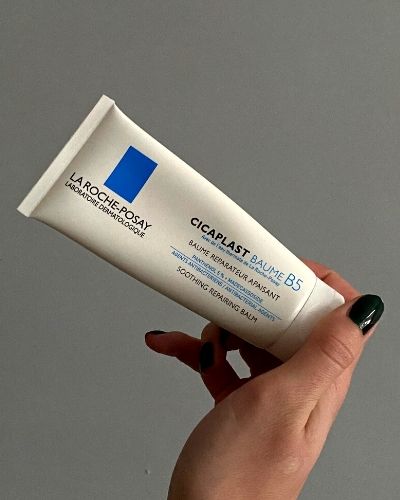
La Roche Posay’s Cicaplast Baume B5 is a multi-purpose soothing cream that can be used on cracked, chapped, dry, and irritated skin to help hydrate and soothe.
It’s suitable for both adults and children and can be used on all areas of the face and body.
Ingredients
This thick balm contains many soothing, repairing, and moisturizing ingredients.
Some of the main ones include softening shea butter, hydrating glycerin, soothing and repairing panthenol, nourishing magnesium, anti-inflammatory zinc, as well as Madecassoside, which is one of the four main compounds in the plant extract Centella Asiatica, an incredibly soothing and repairing agent that helps strengthen the skin barrier.
The Cicaplast Baume B5 is also non-comedogenic, and although it’s quite thick and heavy, there’s nothing here that will clog your pores and cause your skin to break out.
Scent
The Cicaplast Baume B5 doesn’t have added fragrance or other fragrant components such as essential oils, and it doesn’t have any scent.
Consistency
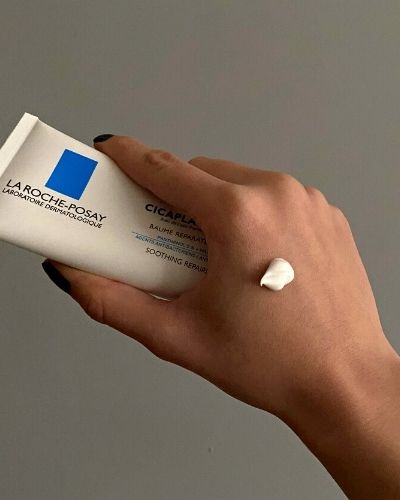
The Cicaplast Baume B5 has the consistency of a thick, creamy balm.
Therefore, it needs to be warmed up between the fingers first before being applied to the skin, as otherwise spreading it around will be difficult since it has a thicker consistency than a regular moisturizer.
How to Use Cicaplast Baume B5 for Acne?
The Cicaplast Baume B5 is not a regular moisturizer, and it can’t be used as such.
The correct way to use the Cicaplast Baume B5 is to warm up a pea-sized amount of product between your fingertips and press it into the skin instead of rubbing it around like a regular moisturizer.
Additionally, the Cicaplast Baume B5 can also be used as a spot treatment and can help soften and smooth out an inflamed pimple.
That said, the Cicaplast Baume B5 doesn’t contain any acne-fighting actives, such as retinoid derivatives, exfoliating acids, or benzoyl peroxide, but its soothing and anti-inflammatory properties can help calm active acne.
To use the Cicaplast Baume B5 for acne, apply a pea-sized amount of product to clean, damp skin or following your regular acne-fighting routine.
Performance
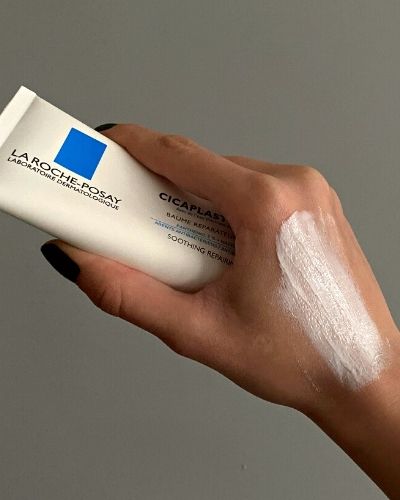
Since the Cicaplast Baume B5 isn’t a regular moisturizer, I like to use it by warming it up between my fingertips and pressing it into my skin in various areas of the face and neck.
Once I have most of the areas covered, I will start rubbing it around very gently to spread the product onto the areas that aren’t covered.
Once I have most of the areas covered, I will start rubbing it around very gently to spread the product onto the areas that aren’t covered.
I also like to do a quick lymphatic drainage massage when I don’t use any actives under the balm. This is very important because you don’t want to move your actives around as this will give you uneven coverage.
That said, the Cicaplast Baume B5 does exactly what it says it does, and it’s always pleasant to see a product actually delivering its claims.
I started using the Cicaplast Baume B5 when my skin wasn’t in a great place and was experiencing extreme dehydration, dryness, peeling, and irritation due to starting tretinoin.
I have since stopped using tretinoin because I didn’t have much luck with it, but the Cicaplast Baume B5 was definitely the product that helped eliminate my tretinoin-induced side effects in the beginning.
I used to apply the Cicaplast Baume B5 before bed, 20-30 minutes after applying tretinoin, and I would feel immediate relief from dryness and irritation.
Cicaplast Baume B5 also helped strengthen my skin barrier and even helped smooth out rough skin texture caused by excessive dehydration.
It also helped soothe inflammation, and my purge-induced pimples always looked slightly better in the morning after I used the Cicaplast Baume B5 the previous evening.
I also never stopped using it even after stopping tretinoin, and I even use it as a weekly mask by applying much more than I usually would and sleeping in it.
Kind of like slugging, but instead of Vaseline or Aquaphor, I use the Cicaplast Baume B5, and my skin is the glowiest it’s ever been when I wake up in the morning after masking with this product.
All that said, there’s one claim I disagree with, and that is Cicaplast Baume B5 not being greasy, according to La Roche Posay’s website.
Yes, this isn’t a greasy oil or a petroleum-based product, but it does leave the skin very moisturized and glowy, which is why, as someone with oily skin, I only use it in the evenings to avoid shine during the day.
This claim isn’t necessarily incorrect; however, I know that folks with oily skin expect a velvety or a slightly matte finish when we read a product is “non-greasy,” and this one definitely leaves a glowy layer on the skin.
In conclusion, the Cicaplast Baume B5 has been a staple in my skincare routine for a long time now, and I see myself purchasing it over and over again.
It’s an excellent product for anyone with dry, dehydrated, irritated, or sensitive skin due to the anti-inflammatory and hydrating ingredients it contains to provide instant relief from dryness and irritation.
On the other hand, the Cicaplast Baume B5 is also good for acne, as it doesn’t contain comedogenic ingredients that could clog the pores and exacerbate current or cause breakouts down the line.
Finally, even though my skin is oily, I still enjoy using this product as a moisturizer; however, as I already mentioned, it does leave a shine behind, so if you also have oily skin, this is something you should expect.
Which One is Better for Acne?
By comparing the two products, the La Roche Posay Cicaplast Baume B5 seems to be more effective for acne-prone skin.
While both products provide excellent hydration, moisturization, and skin-softening effects, the Cicaplast Baume also has anti-inflammatory and soothing properties that can soothe active acne and reduce the appearance of redness and inflammation.
On the other hand, the CeraVe Daily Moisturizing Lotion also contains some ingredients that could be beneficial for acne-prone skin, including barrier-repairing ceramides, hydrating hyaluronic acid, and brightening niacinamide.
However, due to the few potentially comedogenic ingredients, such as fatty alcohols, stearates, and emollients, as well as the personal experience of noticing more breakouts after using it a few times, I would urge anyone dealing with active acne to use the Cerave Daily Moisturizing Lotion with great caution, as it can potentially exacerbate current and cause future breakouts.
That said, both products are fantastic for those with normal, dry, dehydrated, sensitive, and irritated skin due to their soothing and barrier-repairing properties that can help improve skin texture, hydration levels, and overall appearance.
In summary, while both products have their benefits and can work well for different skin types and concerns, the La Roche Posay Cicaplast Baume B5 is a better option for those dealing with acne-prone skin due to its anti-inflammatory and soothing properties.
So, if you’re looking for a product to help calm and improve acne, the Cicaplast Baume B5 may be the better choice for you.
However, if you have other skin concerns or preferences, it’s important to consider those as well in order to find the best fit for your unique skincare needs.
Where to Buy La Roche-Posay Cicaplast Baume B5?
La Roche Posay’s Cicaplast Baume B5 is easily available in most drugstores or pharmacies.
However, the LRP Cicaplast Baume B5 can also be purchased from sites like:
- Feel Unique (EU)
- Beautified You (US and EU)
- Amazon UK (UK)
- Amazon (US)
- Ulta Beauty (US)
Where to Buy Cerave Daily Moisturizing Lotion?
Similarly, the CeraVe Daily Moisturizing Lotion is easily available in most drugstores and pharmacies.
However, the moisturizer can also be purchased from sites like:
- Look Fantastic (EU)
- Amazon UK (UK)
- Amazon (US)
- Ulta Beauty (US)

My name is Simone and I am a certified skin specialist. I created this website to teach my readers how to take great care of their skin and I also like to occasionally share my honest opinions on skincare products I’ve tried. You can learn more about me here.
